Leadership & Management Theories: Application and Impact Analysis
VerifiedAdded on 2023/06/10
|10
|3144
|136
Report
AI Summary
This report explores leadership and management theories, focusing on their application and impact within organizations, particularly EMA Partners. It discusses behavioral, contingency, and transformational leadership theories, alongside scientific, administrative, and human relations management theories. The report analyzes how these theories affect organizational effectiveness, highlighting the importance of adapting leadership styles to different situations. It also examines various leadership and management styles, such as authoritative and democratic, and their influence on decision-making. Furthermore, the report evaluates the significance of organizational culture in enhancing performance, emphasizing factors that contribute to its development. This document, contributed by a student, is available on Desklib, where students can find a wealth of solved assignments and past papers.
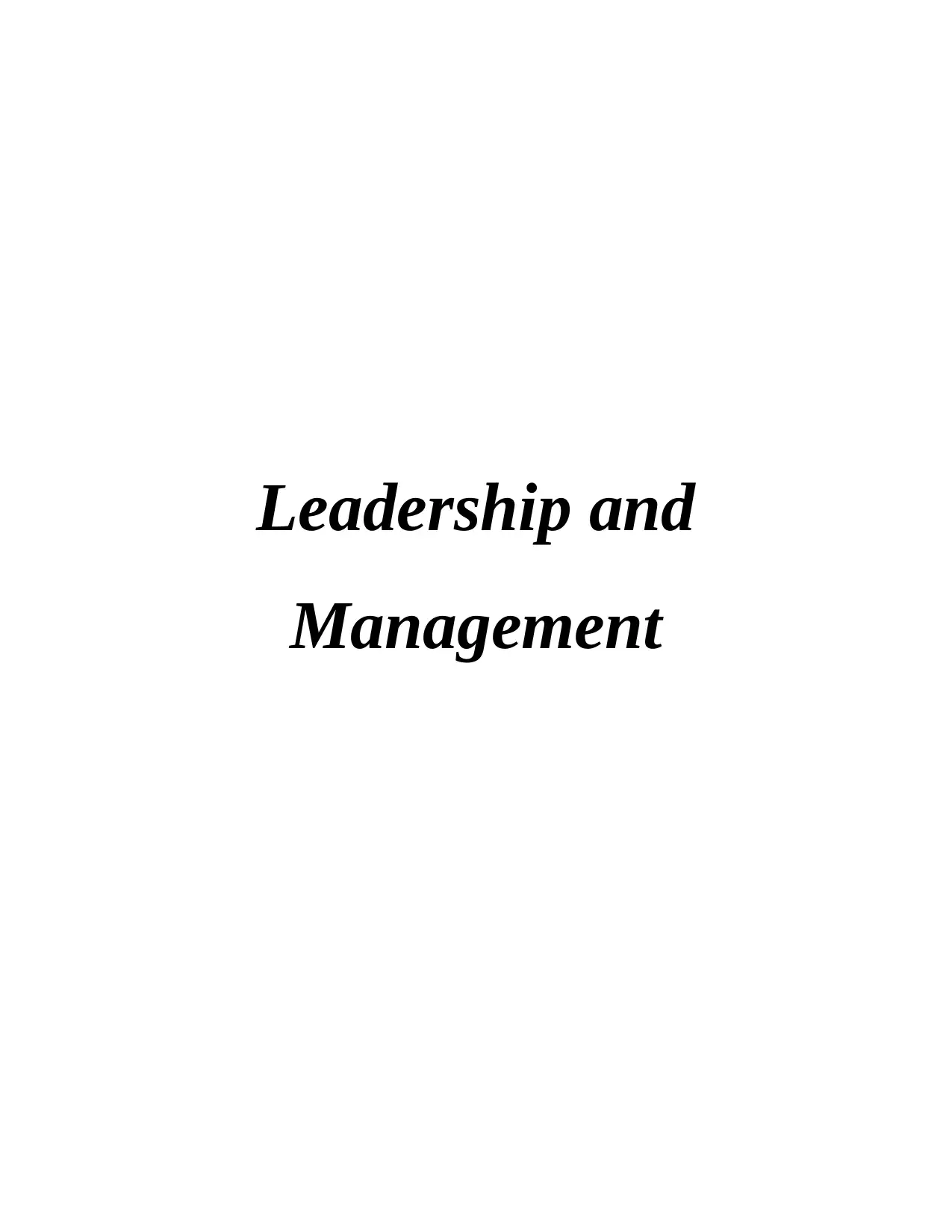
Leadership and
Management
Management
Paraphrase This Document
Need a fresh take? Get an instant paraphrase of this document with our AI Paraphraser
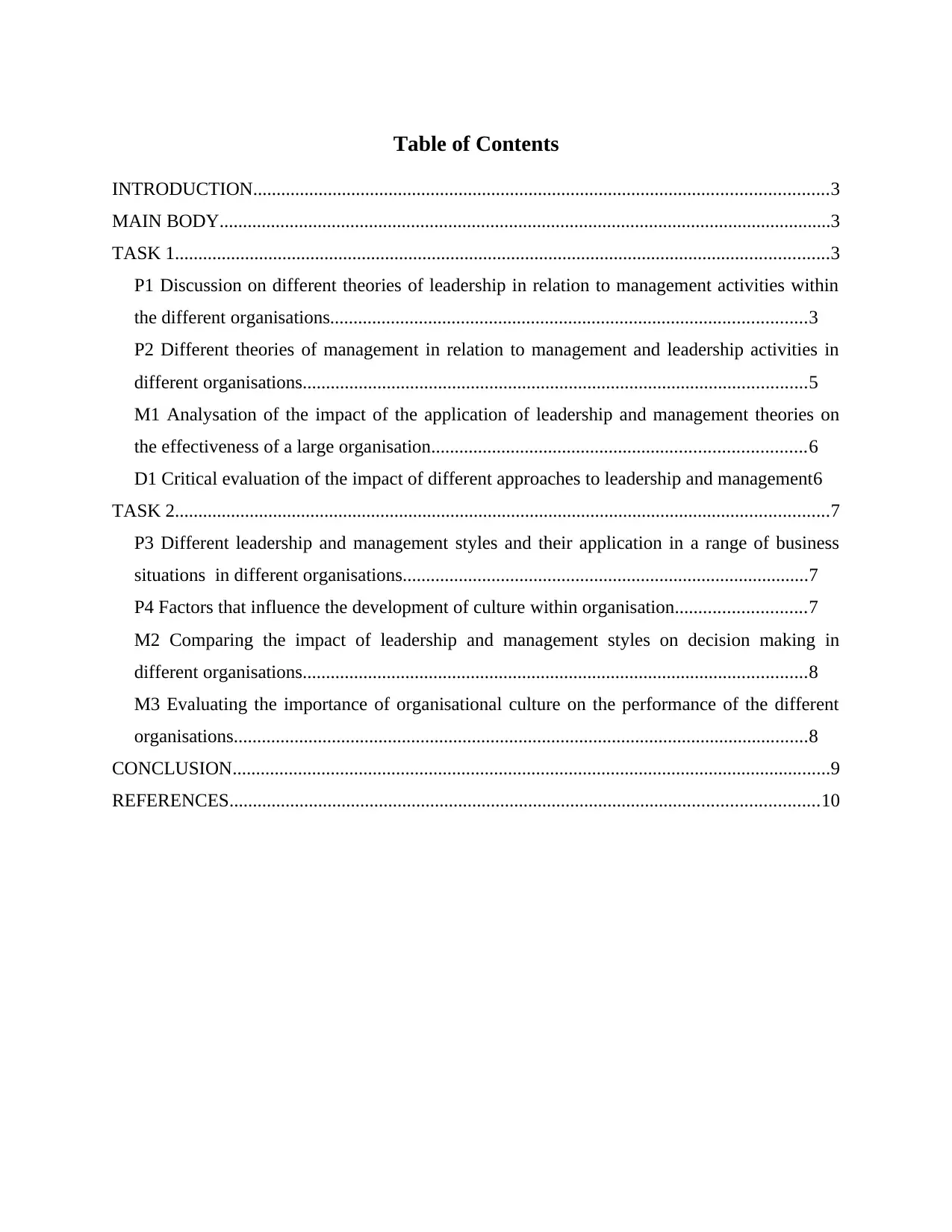
Table of Contents
INTRODUCTION...........................................................................................................................3
MAIN BODY...................................................................................................................................3
TASK 1............................................................................................................................................3
P1 Discussion on different theories of leadership in relation to management activities within
the different organisations......................................................................................................3
P2 Different theories of management in relation to management and leadership activities in
different organisations............................................................................................................5
M1 Analysation of the impact of the application of leadership and management theories on
the effectiveness of a large organisation................................................................................6
D1 Critical evaluation of the impact of different approaches to leadership and management6
TASK 2............................................................................................................................................7
P3 Different leadership and management styles and their application in a range of business
situations in different organisations.......................................................................................7
P4 Factors that influence the development of culture within organisation............................7
M2 Comparing the impact of leadership and management styles on decision making in
different organisations............................................................................................................8
M3 Evaluating the importance of organisational culture on the performance of the different
organisations...........................................................................................................................8
CONCLUSION................................................................................................................................9
REFERENCES..............................................................................................................................10
INTRODUCTION...........................................................................................................................3
MAIN BODY...................................................................................................................................3
TASK 1............................................................................................................................................3
P1 Discussion on different theories of leadership in relation to management activities within
the different organisations......................................................................................................3
P2 Different theories of management in relation to management and leadership activities in
different organisations............................................................................................................5
M1 Analysation of the impact of the application of leadership and management theories on
the effectiveness of a large organisation................................................................................6
D1 Critical evaluation of the impact of different approaches to leadership and management6
TASK 2............................................................................................................................................7
P3 Different leadership and management styles and their application in a range of business
situations in different organisations.......................................................................................7
P4 Factors that influence the development of culture within organisation............................7
M2 Comparing the impact of leadership and management styles on decision making in
different organisations............................................................................................................8
M3 Evaluating the importance of organisational culture on the performance of the different
organisations...........................................................................................................................8
CONCLUSION................................................................................................................................9
REFERENCES..............................................................................................................................10
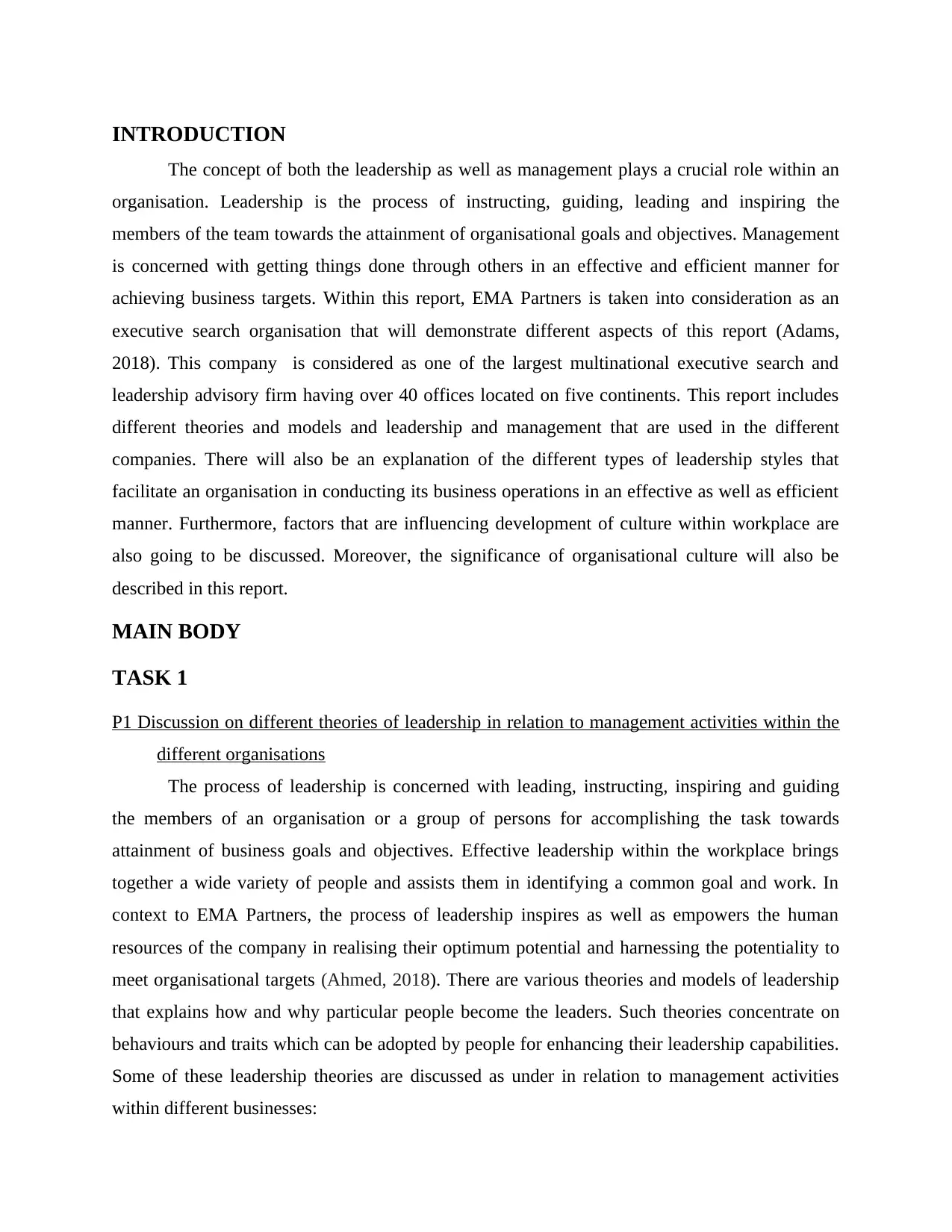
INTRODUCTION
The concept of both the leadership as well as management plays a crucial role within an
organisation. Leadership is the process of instructing, guiding, leading and inspiring the
members of the team towards the attainment of organisational goals and objectives. Management
is concerned with getting things done through others in an effective and efficient manner for
achieving business targets. Within this report, EMA Partners is taken into consideration as an
executive search organisation that will demonstrate different aspects of this report (Adams,
2018). This company is considered as one of the largest multinational executive search and
leadership advisory firm having over 40 offices located on five continents. This report includes
different theories and models and leadership and management that are used in the different
companies. There will also be an explanation of the different types of leadership styles that
facilitate an organisation in conducting its business operations in an effective as well as efficient
manner. Furthermore, factors that are influencing development of culture within workplace are
also going to be discussed. Moreover, the significance of organisational culture will also be
described in this report.
MAIN BODY
TASK 1
P1 Discussion on different theories of leadership in relation to management activities within the
different organisations
The process of leadership is concerned with leading, instructing, inspiring and guiding
the members of an organisation or a group of persons for accomplishing the task towards
attainment of business goals and objectives. Effective leadership within the workplace brings
together a wide variety of people and assists them in identifying a common goal and work. In
context to EMA Partners, the process of leadership inspires as well as empowers the human
resources of the company in realising their optimum potential and harnessing the potentiality to
meet organisational targets (Ahmed, 2018). There are various theories and models of leadership
that explains how and why particular people become the leaders. Such theories concentrate on
behaviours and traits which can be adopted by people for enhancing their leadership capabilities.
Some of these leadership theories are discussed as under in relation to management activities
within different businesses:
The concept of both the leadership as well as management plays a crucial role within an
organisation. Leadership is the process of instructing, guiding, leading and inspiring the
members of the team towards the attainment of organisational goals and objectives. Management
is concerned with getting things done through others in an effective and efficient manner for
achieving business targets. Within this report, EMA Partners is taken into consideration as an
executive search organisation that will demonstrate different aspects of this report (Adams,
2018). This company is considered as one of the largest multinational executive search and
leadership advisory firm having over 40 offices located on five continents. This report includes
different theories and models and leadership and management that are used in the different
companies. There will also be an explanation of the different types of leadership styles that
facilitate an organisation in conducting its business operations in an effective as well as efficient
manner. Furthermore, factors that are influencing development of culture within workplace are
also going to be discussed. Moreover, the significance of organisational culture will also be
described in this report.
MAIN BODY
TASK 1
P1 Discussion on different theories of leadership in relation to management activities within the
different organisations
The process of leadership is concerned with leading, instructing, inspiring and guiding
the members of an organisation or a group of persons for accomplishing the task towards
attainment of business goals and objectives. Effective leadership within the workplace brings
together a wide variety of people and assists them in identifying a common goal and work. In
context to EMA Partners, the process of leadership inspires as well as empowers the human
resources of the company in realising their optimum potential and harnessing the potentiality to
meet organisational targets (Ahmed, 2018). There are various theories and models of leadership
that explains how and why particular people become the leaders. Such theories concentrate on
behaviours and traits which can be adopted by people for enhancing their leadership capabilities.
Some of these leadership theories are discussed as under in relation to management activities
within different businesses:
⊘ This is a preview!⊘
Do you want full access?
Subscribe today to unlock all pages.

Trusted by 1+ million students worldwide
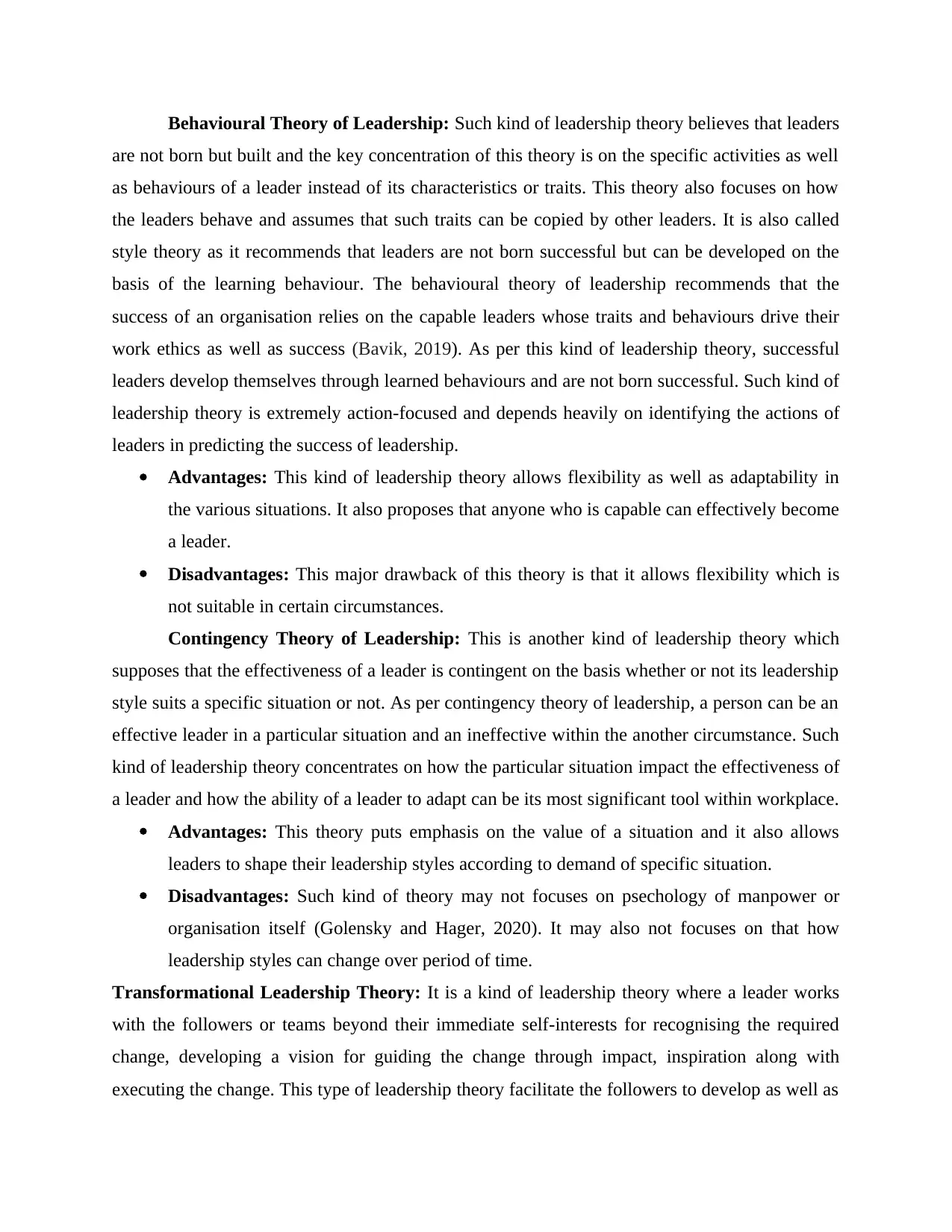
Behavioural Theory of Leadership: Such kind of leadership theory believes that leaders
are not born but built and the key concentration of this theory is on the specific activities as well
as behaviours of a leader instead of its characteristics or traits. This theory also focuses on how
the leaders behave and assumes that such traits can be copied by other leaders. It is also called
style theory as it recommends that leaders are not born successful but can be developed on the
basis of the learning behaviour. The behavioural theory of leadership recommends that the
success of an organisation relies on the capable leaders whose traits and behaviours drive their
work ethics as well as success (Bavik, 2019). As per this kind of leadership theory, successful
leaders develop themselves through learned behaviours and are not born successful. Such kind of
leadership theory is extremely action-focused and depends heavily on identifying the actions of
leaders in predicting the success of leadership.
Advantages: This kind of leadership theory allows flexibility as well as adaptability in
the various situations. It also proposes that anyone who is capable can effectively become
a leader.
Disadvantages: This major drawback of this theory is that it allows flexibility which is
not suitable in certain circumstances.
Contingency Theory of Leadership: This is another kind of leadership theory which
supposes that the effectiveness of a leader is contingent on the basis whether or not its leadership
style suits a specific situation or not. As per contingency theory of leadership, a person can be an
effective leader in a particular situation and an ineffective within the another circumstance. Such
kind of leadership theory concentrates on how the particular situation impact the effectiveness of
a leader and how the ability of a leader to adapt can be its most significant tool within workplace.
Advantages: This theory puts emphasis on the value of a situation and it also allows
leaders to shape their leadership styles according to demand of specific situation.
Disadvantages: Such kind of theory may not focuses on psechology of manpower or
organisation itself (Golensky and Hager, 2020). It may also not focuses on that how
leadership styles can change over period of time.
Transformational Leadership Theory: It is a kind of leadership theory where a leader works
with the followers or teams beyond their immediate self-interests for recognising the required
change, developing a vision for guiding the change through impact, inspiration along with
executing the change. This type of leadership theory facilitate the followers to develop as well as
are not born but built and the key concentration of this theory is on the specific activities as well
as behaviours of a leader instead of its characteristics or traits. This theory also focuses on how
the leaders behave and assumes that such traits can be copied by other leaders. It is also called
style theory as it recommends that leaders are not born successful but can be developed on the
basis of the learning behaviour. The behavioural theory of leadership recommends that the
success of an organisation relies on the capable leaders whose traits and behaviours drive their
work ethics as well as success (Bavik, 2019). As per this kind of leadership theory, successful
leaders develop themselves through learned behaviours and are not born successful. Such kind of
leadership theory is extremely action-focused and depends heavily on identifying the actions of
leaders in predicting the success of leadership.
Advantages: This kind of leadership theory allows flexibility as well as adaptability in
the various situations. It also proposes that anyone who is capable can effectively become
a leader.
Disadvantages: This major drawback of this theory is that it allows flexibility which is
not suitable in certain circumstances.
Contingency Theory of Leadership: This is another kind of leadership theory which
supposes that the effectiveness of a leader is contingent on the basis whether or not its leadership
style suits a specific situation or not. As per contingency theory of leadership, a person can be an
effective leader in a particular situation and an ineffective within the another circumstance. Such
kind of leadership theory concentrates on how the particular situation impact the effectiveness of
a leader and how the ability of a leader to adapt can be its most significant tool within workplace.
Advantages: This theory puts emphasis on the value of a situation and it also allows
leaders to shape their leadership styles according to demand of specific situation.
Disadvantages: Such kind of theory may not focuses on psechology of manpower or
organisation itself (Golensky and Hager, 2020). It may also not focuses on that how
leadership styles can change over period of time.
Transformational Leadership Theory: It is a kind of leadership theory where a leader works
with the followers or teams beyond their immediate self-interests for recognising the required
change, developing a vision for guiding the change through impact, inspiration along with
executing the change. This type of leadership theory facilitate the followers to develop as well as
Paraphrase This Document
Need a fresh take? Get an instant paraphrase of this document with our AI Paraphraser
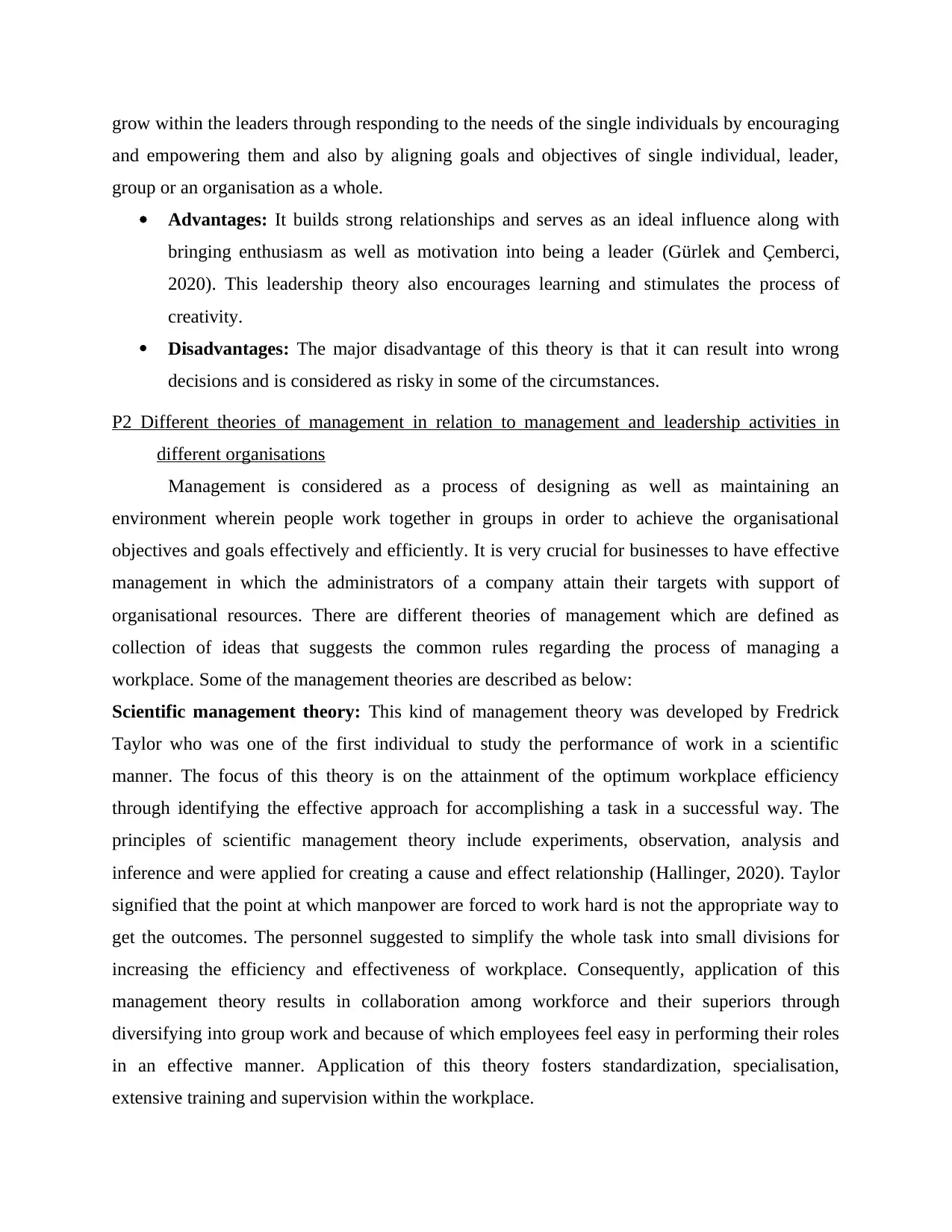
grow within the leaders through responding to the needs of the single individuals by encouraging
and empowering them and also by aligning goals and objectives of single individual, leader,
group or an organisation as a whole.
Advantages: It builds strong relationships and serves as an ideal influence along with
bringing enthusiasm as well as motivation into being a leader (Gürlek and Çemberci,
2020). This leadership theory also encourages learning and stimulates the process of
creativity.
Disadvantages: The major disadvantage of this theory is that it can result into wrong
decisions and is considered as risky in some of the circumstances.
P2 Different theories of management in relation to management and leadership activities in
different organisations
Management is considered as a process of designing as well as maintaining an
environment wherein people work together in groups in order to achieve the organisational
objectives and goals effectively and efficiently. It is very crucial for businesses to have effective
management in which the administrators of a company attain their targets with support of
organisational resources. There are different theories of management which are defined as
collection of ideas that suggests the common rules regarding the process of managing a
workplace. Some of the management theories are described as below:
Scientific management theory: This kind of management theory was developed by Fredrick
Taylor who was one of the first individual to study the performance of work in a scientific
manner. The focus of this theory is on the attainment of the optimum workplace efficiency
through identifying the effective approach for accomplishing a task in a successful way. The
principles of scientific management theory include experiments, observation, analysis and
inference and were applied for creating a cause and effect relationship (Hallinger, 2020). Taylor
signified that the point at which manpower are forced to work hard is not the appropriate way to
get the outcomes. The personnel suggested to simplify the whole task into small divisions for
increasing the efficiency and effectiveness of workplace. Consequently, application of this
management theory results in collaboration among workforce and their superiors through
diversifying into group work and because of which employees feel easy in performing their roles
in an effective manner. Application of this theory fosters standardization, specialisation,
extensive training and supervision within the workplace.
and empowering them and also by aligning goals and objectives of single individual, leader,
group or an organisation as a whole.
Advantages: It builds strong relationships and serves as an ideal influence along with
bringing enthusiasm as well as motivation into being a leader (Gürlek and Çemberci,
2020). This leadership theory also encourages learning and stimulates the process of
creativity.
Disadvantages: The major disadvantage of this theory is that it can result into wrong
decisions and is considered as risky in some of the circumstances.
P2 Different theories of management in relation to management and leadership activities in
different organisations
Management is considered as a process of designing as well as maintaining an
environment wherein people work together in groups in order to achieve the organisational
objectives and goals effectively and efficiently. It is very crucial for businesses to have effective
management in which the administrators of a company attain their targets with support of
organisational resources. There are different theories of management which are defined as
collection of ideas that suggests the common rules regarding the process of managing a
workplace. Some of the management theories are described as below:
Scientific management theory: This kind of management theory was developed by Fredrick
Taylor who was one of the first individual to study the performance of work in a scientific
manner. The focus of this theory is on the attainment of the optimum workplace efficiency
through identifying the effective approach for accomplishing a task in a successful way. The
principles of scientific management theory include experiments, observation, analysis and
inference and were applied for creating a cause and effect relationship (Hallinger, 2020). Taylor
signified that the point at which manpower are forced to work hard is not the appropriate way to
get the outcomes. The personnel suggested to simplify the whole task into small divisions for
increasing the efficiency and effectiveness of workplace. Consequently, application of this
management theory results in collaboration among workforce and their superiors through
diversifying into group work and because of which employees feel easy in performing their roles
in an effective manner. Application of this theory fosters standardization, specialisation,
extensive training and supervision within the workplace.
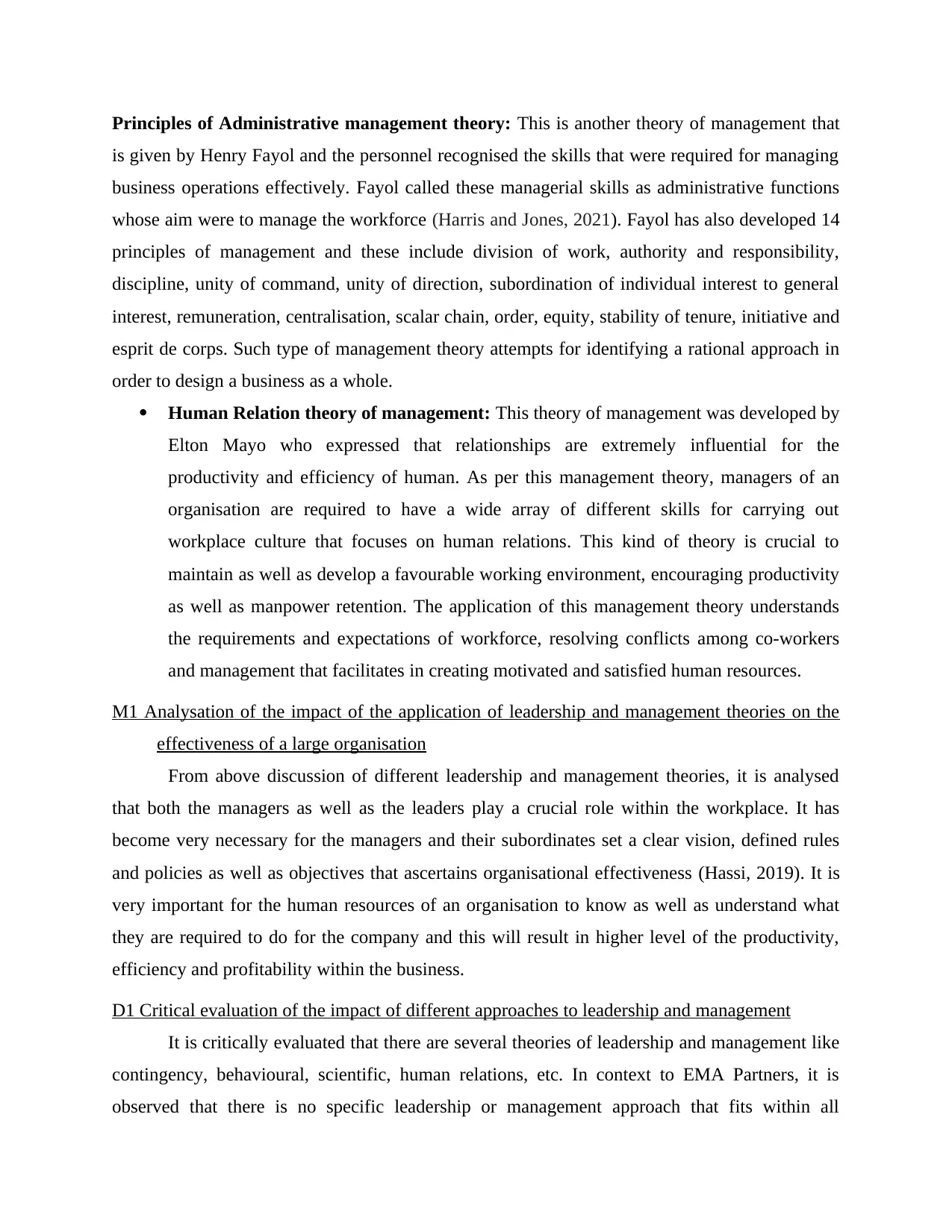
Principles of Administrative management theory: This is another theory of management that
is given by Henry Fayol and the personnel recognised the skills that were required for managing
business operations effectively. Fayol called these managerial skills as administrative functions
whose aim were to manage the workforce (Harris and Jones, 2021). Fayol has also developed 14
principles of management and these include division of work, authority and responsibility,
discipline, unity of command, unity of direction, subordination of individual interest to general
interest, remuneration, centralisation, scalar chain, order, equity, stability of tenure, initiative and
esprit de corps. Such type of management theory attempts for identifying a rational approach in
order to design a business as a whole.
Human Relation theory of management: This theory of management was developed by
Elton Mayo who expressed that relationships are extremely influential for the
productivity and efficiency of human. As per this management theory, managers of an
organisation are required to have a wide array of different skills for carrying out
workplace culture that focuses on human relations. This kind of theory is crucial to
maintain as well as develop a favourable working environment, encouraging productivity
as well as manpower retention. The application of this management theory understands
the requirements and expectations of workforce, resolving conflicts among co-workers
and management that facilitates in creating motivated and satisfied human resources.
M1 Analysation of the impact of the application of leadership and management theories on the
effectiveness of a large organisation
From above discussion of different leadership and management theories, it is analysed
that both the managers as well as the leaders play a crucial role within the workplace. It has
become very necessary for the managers and their subordinates set a clear vision, defined rules
and policies as well as objectives that ascertains organisational effectiveness (Hassi, 2019). It is
very important for the human resources of an organisation to know as well as understand what
they are required to do for the company and this will result in higher level of the productivity,
efficiency and profitability within the business.
D1 Critical evaluation of the impact of different approaches to leadership and management
It is critically evaluated that there are several theories of leadership and management like
contingency, behavioural, scientific, human relations, etc. In context to EMA Partners, it is
observed that there is no specific leadership or management approach that fits within all
is given by Henry Fayol and the personnel recognised the skills that were required for managing
business operations effectively. Fayol called these managerial skills as administrative functions
whose aim were to manage the workforce (Harris and Jones, 2021). Fayol has also developed 14
principles of management and these include division of work, authority and responsibility,
discipline, unity of command, unity of direction, subordination of individual interest to general
interest, remuneration, centralisation, scalar chain, order, equity, stability of tenure, initiative and
esprit de corps. Such type of management theory attempts for identifying a rational approach in
order to design a business as a whole.
Human Relation theory of management: This theory of management was developed by
Elton Mayo who expressed that relationships are extremely influential for the
productivity and efficiency of human. As per this management theory, managers of an
organisation are required to have a wide array of different skills for carrying out
workplace culture that focuses on human relations. This kind of theory is crucial to
maintain as well as develop a favourable working environment, encouraging productivity
as well as manpower retention. The application of this management theory understands
the requirements and expectations of workforce, resolving conflicts among co-workers
and management that facilitates in creating motivated and satisfied human resources.
M1 Analysation of the impact of the application of leadership and management theories on the
effectiveness of a large organisation
From above discussion of different leadership and management theories, it is analysed
that both the managers as well as the leaders play a crucial role within the workplace. It has
become very necessary for the managers and their subordinates set a clear vision, defined rules
and policies as well as objectives that ascertains organisational effectiveness (Hassi, 2019). It is
very important for the human resources of an organisation to know as well as understand what
they are required to do for the company and this will result in higher level of the productivity,
efficiency and profitability within the business.
D1 Critical evaluation of the impact of different approaches to leadership and management
It is critically evaluated that there are several theories of leadership and management like
contingency, behavioural, scientific, human relations, etc. In context to EMA Partners, it is
observed that there is no specific leadership or management approach that fits within all
⊘ This is a preview!⊘
Do you want full access?
Subscribe today to unlock all pages.

Trusted by 1+ million students worldwide
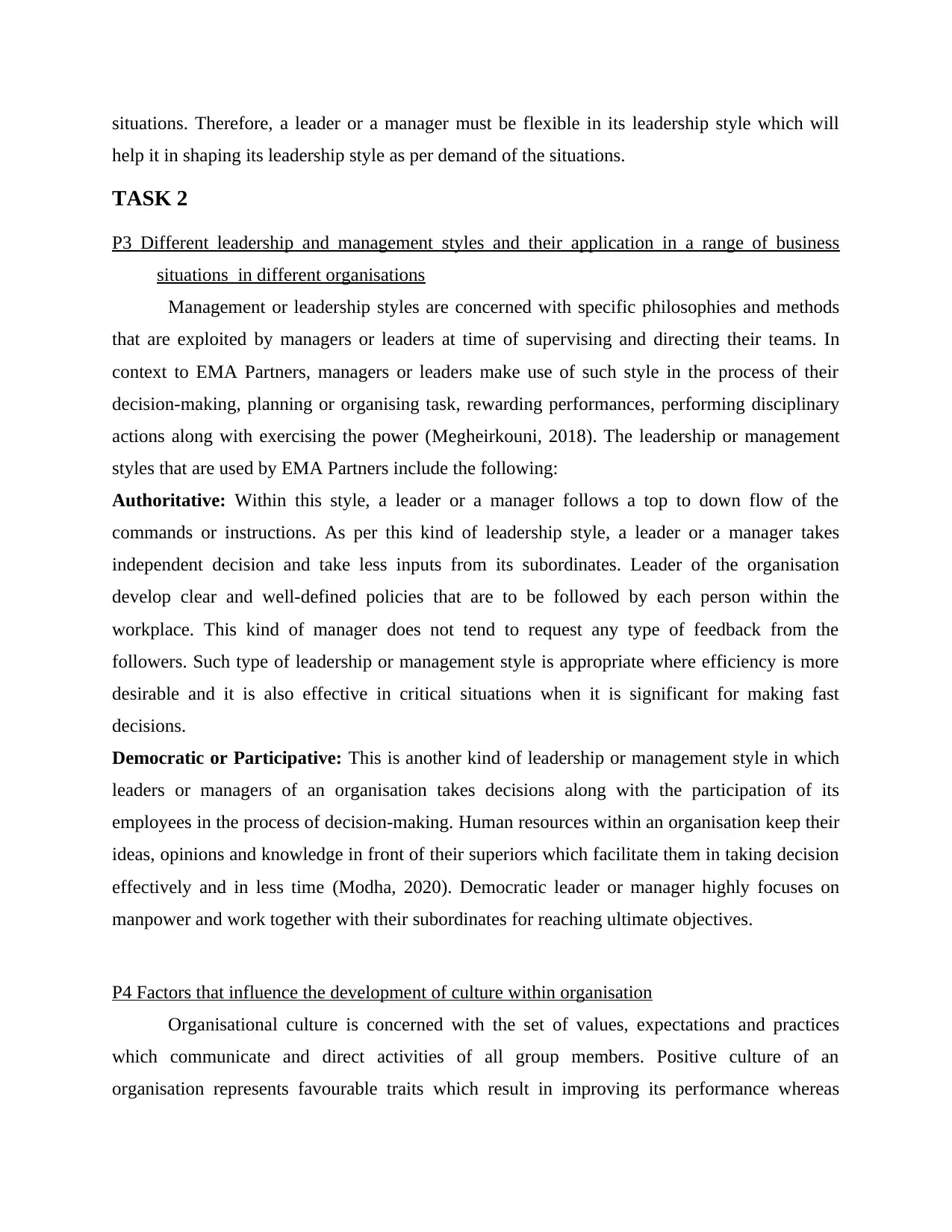
situations. Therefore, a leader or a manager must be flexible in its leadership style which will
help it in shaping its leadership style as per demand of the situations.
TASK 2
P3 Different leadership and management styles and their application in a range of business
situations in different organisations
Management or leadership styles are concerned with specific philosophies and methods
that are exploited by managers or leaders at time of supervising and directing their teams. In
context to EMA Partners, managers or leaders make use of such style in the process of their
decision-making, planning or organising task, rewarding performances, performing disciplinary
actions along with exercising the power (Megheirkouni, 2018). The leadership or management
styles that are used by EMA Partners include the following:
Authoritative: Within this style, a leader or a manager follows a top to down flow of the
commands or instructions. As per this kind of leadership style, a leader or a manager takes
independent decision and take less inputs from its subordinates. Leader of the organisation
develop clear and well-defined policies that are to be followed by each person within the
workplace. This kind of manager does not tend to request any type of feedback from the
followers. Such type of leadership or management style is appropriate where efficiency is more
desirable and it is also effective in critical situations when it is significant for making fast
decisions.
Democratic or Participative: This is another kind of leadership or management style in which
leaders or managers of an organisation takes decisions along with the participation of its
employees in the process of decision-making. Human resources within an organisation keep their
ideas, opinions and knowledge in front of their superiors which facilitate them in taking decision
effectively and in less time (Modha, 2020). Democratic leader or manager highly focuses on
manpower and work together with their subordinates for reaching ultimate objectives.
P4 Factors that influence the development of culture within organisation
Organisational culture is concerned with the set of values, expectations and practices
which communicate and direct activities of all group members. Positive culture of an
organisation represents favourable traits which result in improving its performance whereas
help it in shaping its leadership style as per demand of the situations.
TASK 2
P3 Different leadership and management styles and their application in a range of business
situations in different organisations
Management or leadership styles are concerned with specific philosophies and methods
that are exploited by managers or leaders at time of supervising and directing their teams. In
context to EMA Partners, managers or leaders make use of such style in the process of their
decision-making, planning or organising task, rewarding performances, performing disciplinary
actions along with exercising the power (Megheirkouni, 2018). The leadership or management
styles that are used by EMA Partners include the following:
Authoritative: Within this style, a leader or a manager follows a top to down flow of the
commands or instructions. As per this kind of leadership style, a leader or a manager takes
independent decision and take less inputs from its subordinates. Leader of the organisation
develop clear and well-defined policies that are to be followed by each person within the
workplace. This kind of manager does not tend to request any type of feedback from the
followers. Such type of leadership or management style is appropriate where efficiency is more
desirable and it is also effective in critical situations when it is significant for making fast
decisions.
Democratic or Participative: This is another kind of leadership or management style in which
leaders or managers of an organisation takes decisions along with the participation of its
employees in the process of decision-making. Human resources within an organisation keep their
ideas, opinions and knowledge in front of their superiors which facilitate them in taking decision
effectively and in less time (Modha, 2020). Democratic leader or manager highly focuses on
manpower and work together with their subordinates for reaching ultimate objectives.
P4 Factors that influence the development of culture within organisation
Organisational culture is concerned with the set of values, expectations and practices
which communicate and direct activities of all group members. Positive culture of an
organisation represents favourable traits which result in improving its performance whereas
Paraphrase This Document
Need a fresh take? Get an instant paraphrase of this document with our AI Paraphraser
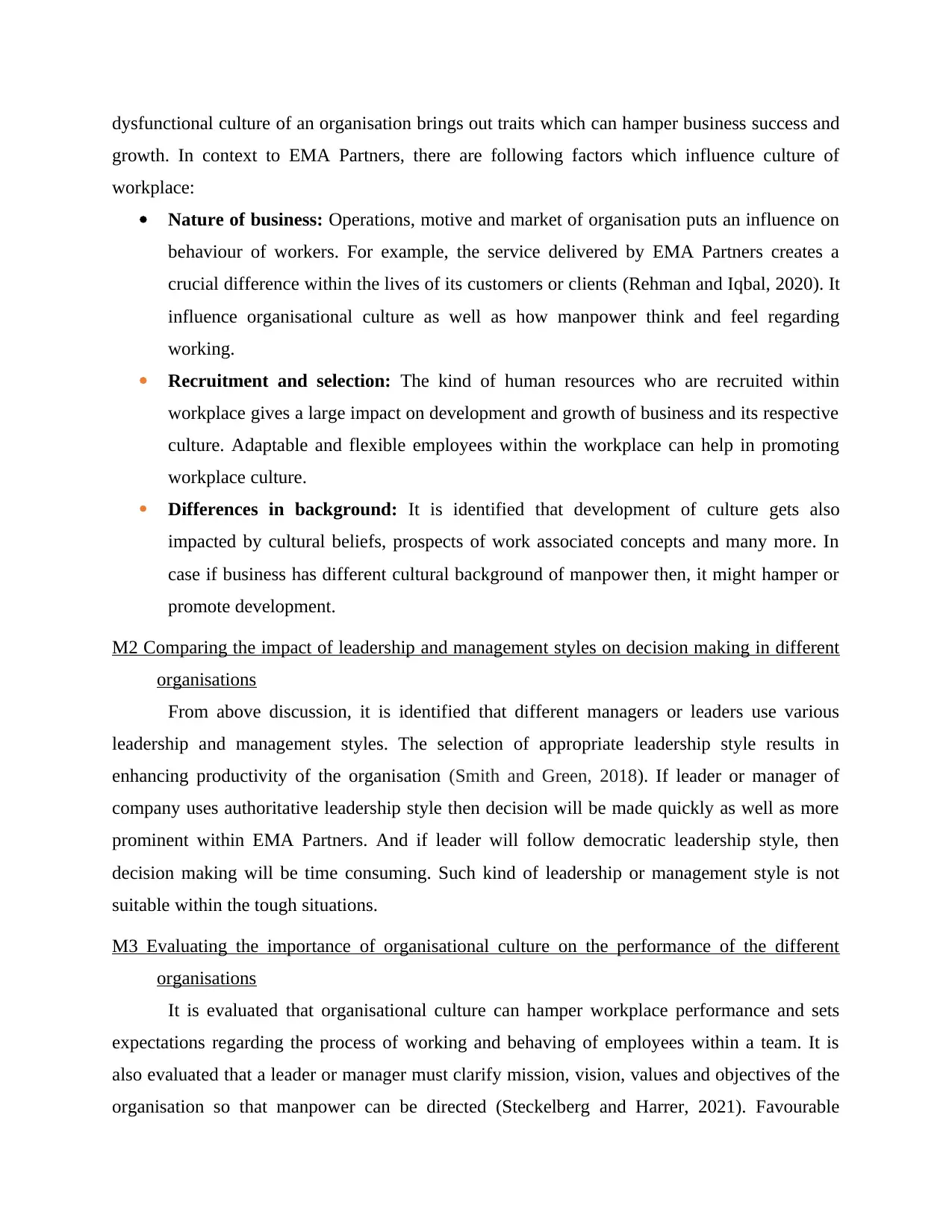
dysfunctional culture of an organisation brings out traits which can hamper business success and
growth. In context to EMA Partners, there are following factors which influence culture of
workplace:
Nature of business: Operations, motive and market of organisation puts an influence on
behaviour of workers. For example, the service delivered by EMA Partners creates a
crucial difference within the lives of its customers or clients (Rehman and Iqbal, 2020). It
influence organisational culture as well as how manpower think and feel regarding
working.
Recruitment and selection: The kind of human resources who are recruited within
workplace gives a large impact on development and growth of business and its respective
culture. Adaptable and flexible employees within the workplace can help in promoting
workplace culture.
Differences in background: It is identified that development of culture gets also
impacted by cultural beliefs, prospects of work associated concepts and many more. In
case if business has different cultural background of manpower then, it might hamper or
promote development.
M2 Comparing the impact of leadership and management styles on decision making in different
organisations
From above discussion, it is identified that different managers or leaders use various
leadership and management styles. The selection of appropriate leadership style results in
enhancing productivity of the organisation (Smith and Green, 2018). If leader or manager of
company uses authoritative leadership style then decision will be made quickly as well as more
prominent within EMA Partners. And if leader will follow democratic leadership style, then
decision making will be time consuming. Such kind of leadership or management style is not
suitable within the tough situations.
M3 Evaluating the importance of organisational culture on the performance of the different
organisations
It is evaluated that organisational culture can hamper workplace performance and sets
expectations regarding the process of working and behaving of employees within a team. It is
also evaluated that a leader or manager must clarify mission, vision, values and objectives of the
organisation so that manpower can be directed (Steckelberg and Harrer, 2021). Favourable
growth. In context to EMA Partners, there are following factors which influence culture of
workplace:
Nature of business: Operations, motive and market of organisation puts an influence on
behaviour of workers. For example, the service delivered by EMA Partners creates a
crucial difference within the lives of its customers or clients (Rehman and Iqbal, 2020). It
influence organisational culture as well as how manpower think and feel regarding
working.
Recruitment and selection: The kind of human resources who are recruited within
workplace gives a large impact on development and growth of business and its respective
culture. Adaptable and flexible employees within the workplace can help in promoting
workplace culture.
Differences in background: It is identified that development of culture gets also
impacted by cultural beliefs, prospects of work associated concepts and many more. In
case if business has different cultural background of manpower then, it might hamper or
promote development.
M2 Comparing the impact of leadership and management styles on decision making in different
organisations
From above discussion, it is identified that different managers or leaders use various
leadership and management styles. The selection of appropriate leadership style results in
enhancing productivity of the organisation (Smith and Green, 2018). If leader or manager of
company uses authoritative leadership style then decision will be made quickly as well as more
prominent within EMA Partners. And if leader will follow democratic leadership style, then
decision making will be time consuming. Such kind of leadership or management style is not
suitable within the tough situations.
M3 Evaluating the importance of organisational culture on the performance of the different
organisations
It is evaluated that organisational culture can hamper workplace performance and sets
expectations regarding the process of working and behaving of employees within a team. It is
also evaluated that a leader or manager must clarify mission, vision, values and objectives of the
organisation so that manpower can be directed (Steckelberg and Harrer, 2021). Favourable
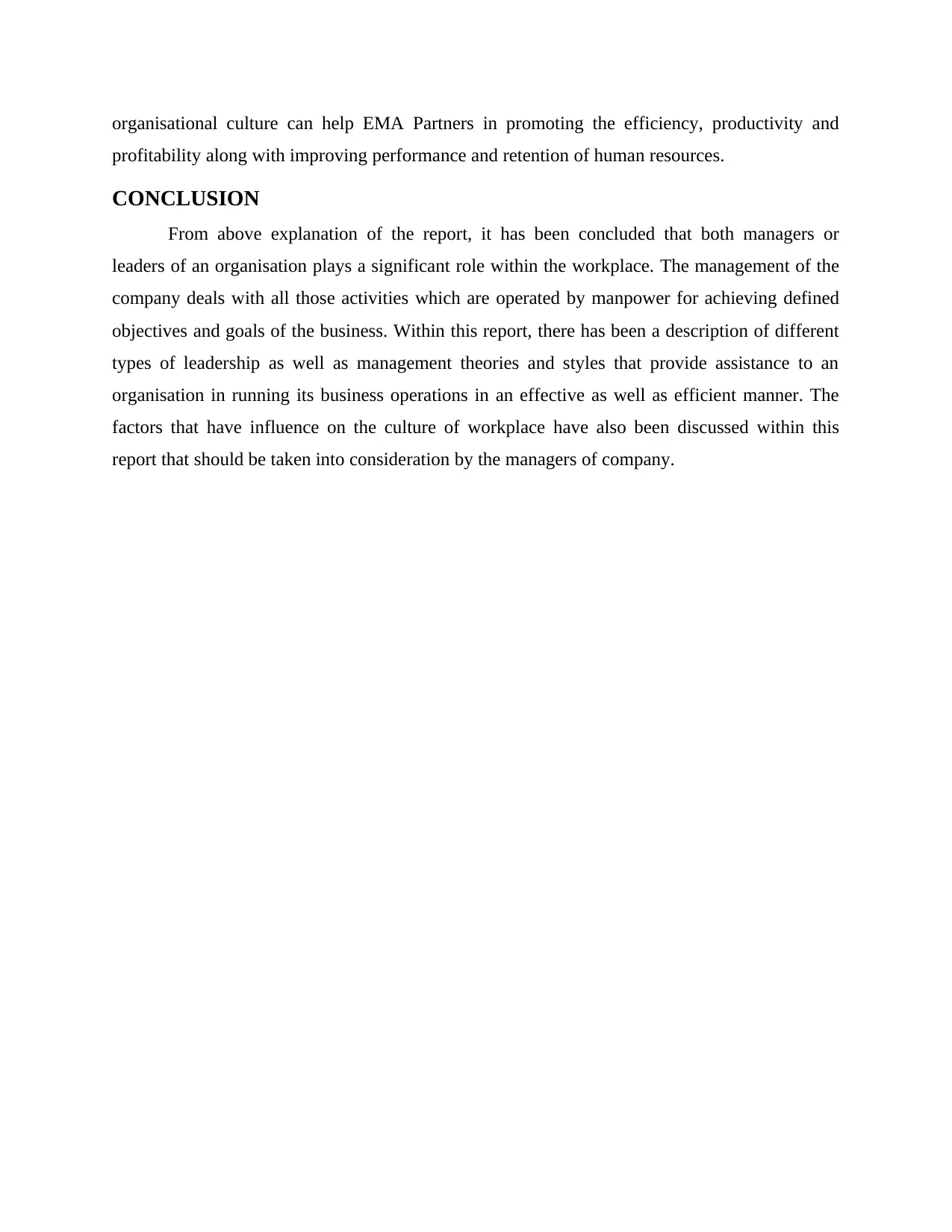
organisational culture can help EMA Partners in promoting the efficiency, productivity and
profitability along with improving performance and retention of human resources.
CONCLUSION
From above explanation of the report, it has been concluded that both managers or
leaders of an organisation plays a significant role within the workplace. The management of the
company deals with all those activities which are operated by manpower for achieving defined
objectives and goals of the business. Within this report, there has been a description of different
types of leadership as well as management theories and styles that provide assistance to an
organisation in running its business operations in an effective as well as efficient manner. The
factors that have influence on the culture of workplace have also been discussed within this
report that should be taken into consideration by the managers of company.
profitability along with improving performance and retention of human resources.
CONCLUSION
From above explanation of the report, it has been concluded that both managers or
leaders of an organisation plays a significant role within the workplace. The management of the
company deals with all those activities which are operated by manpower for achieving defined
objectives and goals of the business. Within this report, there has been a description of different
types of leadership as well as management theories and styles that provide assistance to an
organisation in running its business operations in an effective as well as efficient manner. The
factors that have influence on the culture of workplace have also been discussed within this
report that should be taken into consideration by the managers of company.
⊘ This is a preview!⊘
Do you want full access?
Subscribe today to unlock all pages.

Trusted by 1+ million students worldwide
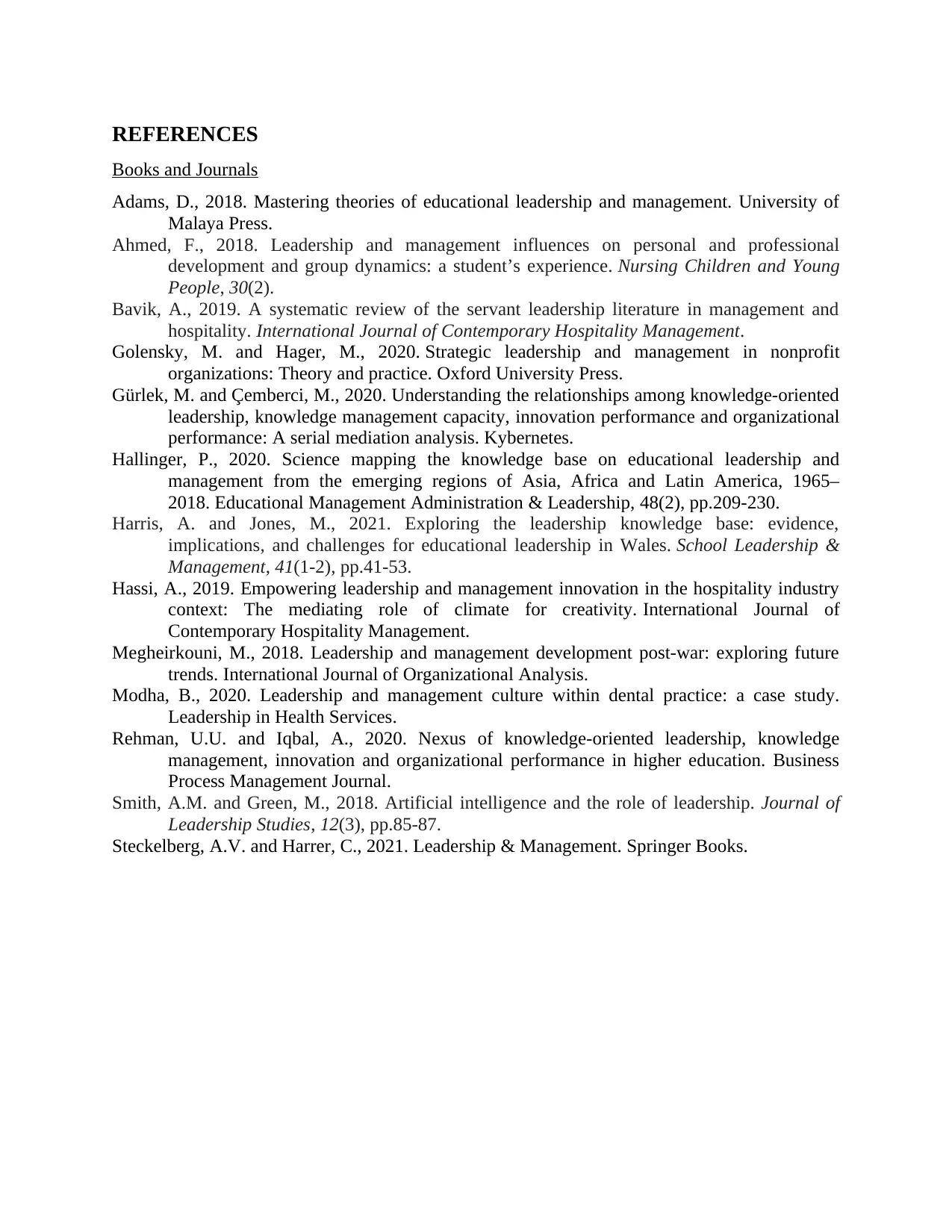
REFERENCES
Books and Journals
Adams, D., 2018. Mastering theories of educational leadership and management. University of
Malaya Press.
Ahmed, F., 2018. Leadership and management influences on personal and professional
development and group dynamics: a student’s experience. Nursing Children and Young
People, 30(2).
Bavik, A., 2019. A systematic review of the servant leadership literature in management and
hospitality. International Journal of Contemporary Hospitality Management.
Golensky, M. and Hager, M., 2020. Strategic leadership and management in nonprofit
organizations: Theory and practice. Oxford University Press.
Gürlek, M. and Çemberci, M., 2020. Understanding the relationships among knowledge-oriented
leadership, knowledge management capacity, innovation performance and organizational
performance: A serial mediation analysis. Kybernetes.
Hallinger, P., 2020. Science mapping the knowledge base on educational leadership and
management from the emerging regions of Asia, Africa and Latin America, 1965–
2018. Educational Management Administration & Leadership, 48(2), pp.209-230.
Harris, A. and Jones, M., 2021. Exploring the leadership knowledge base: evidence,
implications, and challenges for educational leadership in Wales. School Leadership &
Management, 41(1-2), pp.41-53.
Hassi, A., 2019. Empowering leadership and management innovation in the hospitality industry
context: The mediating role of climate for creativity. International Journal of
Contemporary Hospitality Management.
Megheirkouni, M., 2018. Leadership and management development post-war: exploring future
trends. International Journal of Organizational Analysis.
Modha, B., 2020. Leadership and management culture within dental practice: a case study.
Leadership in Health Services.
Rehman, U.U. and Iqbal, A., 2020. Nexus of knowledge-oriented leadership, knowledge
management, innovation and organizational performance in higher education. Business
Process Management Journal.
Smith, A.M. and Green, M., 2018. Artificial intelligence and the role of leadership. Journal of
Leadership Studies, 12(3), pp.85-87.
Steckelberg, A.V. and Harrer, C., 2021. Leadership & Management. Springer Books.
Books and Journals
Adams, D., 2018. Mastering theories of educational leadership and management. University of
Malaya Press.
Ahmed, F., 2018. Leadership and management influences on personal and professional
development and group dynamics: a student’s experience. Nursing Children and Young
People, 30(2).
Bavik, A., 2019. A systematic review of the servant leadership literature in management and
hospitality. International Journal of Contemporary Hospitality Management.
Golensky, M. and Hager, M., 2020. Strategic leadership and management in nonprofit
organizations: Theory and practice. Oxford University Press.
Gürlek, M. and Çemberci, M., 2020. Understanding the relationships among knowledge-oriented
leadership, knowledge management capacity, innovation performance and organizational
performance: A serial mediation analysis. Kybernetes.
Hallinger, P., 2020. Science mapping the knowledge base on educational leadership and
management from the emerging regions of Asia, Africa and Latin America, 1965–
2018. Educational Management Administration & Leadership, 48(2), pp.209-230.
Harris, A. and Jones, M., 2021. Exploring the leadership knowledge base: evidence,
implications, and challenges for educational leadership in Wales. School Leadership &
Management, 41(1-2), pp.41-53.
Hassi, A., 2019. Empowering leadership and management innovation in the hospitality industry
context: The mediating role of climate for creativity. International Journal of
Contemporary Hospitality Management.
Megheirkouni, M., 2018. Leadership and management development post-war: exploring future
trends. International Journal of Organizational Analysis.
Modha, B., 2020. Leadership and management culture within dental practice: a case study.
Leadership in Health Services.
Rehman, U.U. and Iqbal, A., 2020. Nexus of knowledge-oriented leadership, knowledge
management, innovation and organizational performance in higher education. Business
Process Management Journal.
Smith, A.M. and Green, M., 2018. Artificial intelligence and the role of leadership. Journal of
Leadership Studies, 12(3), pp.85-87.
Steckelberg, A.V. and Harrer, C., 2021. Leadership & Management. Springer Books.
1 out of 10
Related Documents
Your All-in-One AI-Powered Toolkit for Academic Success.
+13062052269
info@desklib.com
Available 24*7 on WhatsApp / Email
![[object Object]](/_next/static/media/star-bottom.7253800d.svg)
Unlock your academic potential
Copyright © 2020–2025 A2Z Services. All Rights Reserved. Developed and managed by ZUCOL.



